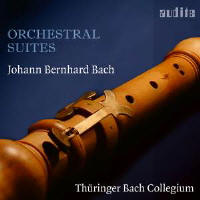Texte paru dans: / Appeared in: Audite |
|
|
Reviewer: Bertil
van Boer
One of the main issues lurking
in the background of any research on the music of Johann Sebastian Bach is
that he was part of a larger family, all of whom had served the central
German region as musicians and composers for over a century prior. While we
focus on Leipzig, Cöthen, and other places where Bach worked, he was in
constant contact with his various cousins, both close and distant. Indeed,
much of Thuringia was a family affair, and though one focuses on the cantor
at St. Thomas Church and his four talented progeny, the region was
practically awash with various relatives, each of whom was contributing to
the development of the late Baroque style. Fortunately, men such as Johann
Ernst Bach and Christoph Bach have begun to emerge from the long shadow cast
by their famous relative, but much still needs to be done to create a
holistic view of the Bach family contributions. With this in mind, we should
welcome this set of four orchestral suites by Johann Bernhard Bach
(1676–1749), an elder cousin of Johann Sebastian who passed away only a year
before. Johann Bernhard came from the line of Johann Aegidius of the Erfurt
branch. Born there, he received his education from his father, and in 1695
was appointed by the city fathers as organist in the Kaufmannskirche. His
reputation rapidly advanced and he was recruited as organist in the city of
Magdeburg, before in 1703 the court as Eisenach appointed him successor to
his uncle Johann Christoph. Here, he like Johann Sebastian in Cöthen was a
court musician, specializing in keyboard performance, both at court and in
the city churches. Here he came into contact with Georg Philipp Telemann,
when that composer held the appointment as Kapellmeister during the years
1708–1712. He remained there for the remainder of his life, with his son
Johann Ernst acting as colleague and successor.
The interaction between Johann
Bernhard and Johann Sebastian was close; both acted as godfathers to sons,
and it is clear that they exchanged music for performance in their various
towns. Unfortunately, much of Johann Bernhard’s works still remain to be
recovered; what exists today consists of the four orchestral suites recorded
here and a small number of organ works. His obituary, however, notes in 1749
that he was noted for his numerous “overtures” though with the odd comment
that they reflected Telemann’s style. While it may well be that the talented
Telemann’s short sojourn in Eisenach may have resulted in mutual musical
influences, such a statement is to be taken with a great deal of salt. The
implication that the orchestral suites were imitations may be invidious, but
Johann Sebastian thought enough of them to perform at least three regularly
with his Leipzig collegium, and the fourth exists in a manuscript set of
parts that was probably derived from Emanuel Bach’s musicalia in Berlin. All four of the suites conform to the conventions of the time, being a series of stylized dances following a French overture. The scoring is the usual strings, with the addition of discrete woodwind parts; since only one of them is in the usual trumpet key of D Major, such instrumentation is not exceptional. The D-Major Suite (No. 4) may originally have had these, but the only source from Leipzig omits them. Each opens with a stylized French overture. That in the Fourth Suite is regal and gripping in the powerful dotted rhythms of the opening, making the following fast section a lively compound meter gigue. This contrasts with the pensive beginning to the Third Suite, with its soft transverse flutes. Doubled by the oboes, the textures create a gently flowing movement that devolves into a sort of concerto grosso with solo woodwinds and lines that flow over themselves, much as Johann Sebastian’s concertos are wont to do. The individual movements do not always follow the French-inspired conventions that dominate the latter’s suites. For example, the sixth movement of the E-Minor Suite is a lively Rigadon with swirling lines, while the three caprices of the D-Major Suite are each short interludes into the dance structure; the first is regal and stately, the second moves along at an easy running pace, while the third that concludes the suite is characterized by solemn dotted rhythms, thus brining the work full circle. In the first suite, the fifth movement is entitled “Fantasie,” with an insistent sense of melancholy, while the air of the Second Suite is light and airy. This particular suite ends with a movement entitled “The Tempest,” which is the overture taken from Agostino Steffani’s Il Zela di Leonato, which was produced with success in Hannover in 1691, and which Bach clearly thought would be a good conclusion to his shortest suite. The final tempest portion swirls about in musical eddies and changing musical currents. The Thüringer Bach Collegium produces a fully appropriate ensemble for this music with clear instrumental definition, not to mention a good sense of texture and tempos. The latter are lively but not rushed, and one finds that the instruments are all clear and in tune. The works demonstrate more intricacies than his nephew’s similar suites, though they are not quite as powerful in terms of instrumentation or memorable tunes. The dance background is emphasized but not overwhelming, and their excellent interpretation shows that Johann Bernhard was an innovative and intelligent composer, fully versed in the prevalent styles of his time, though he also includes a sense of musical whimsy that makes these works more akin to Telemann than his nephew. This is one disc that is well worth obtaining, both for the fine performance and for the elegant music. | |
|
|
|
|
|
|
|
Cliquez l'un ou l'autre
bouton pour découvrir bien d'autres critiques de CD |
|




